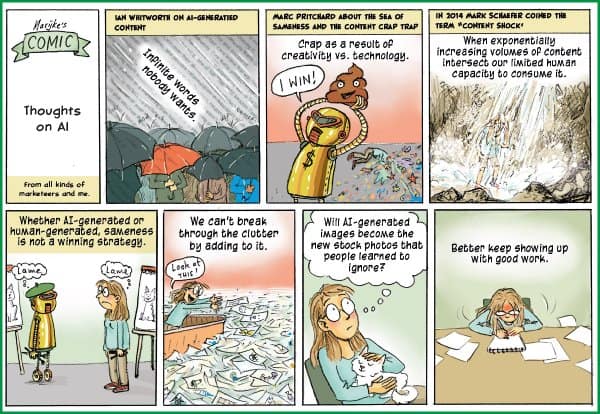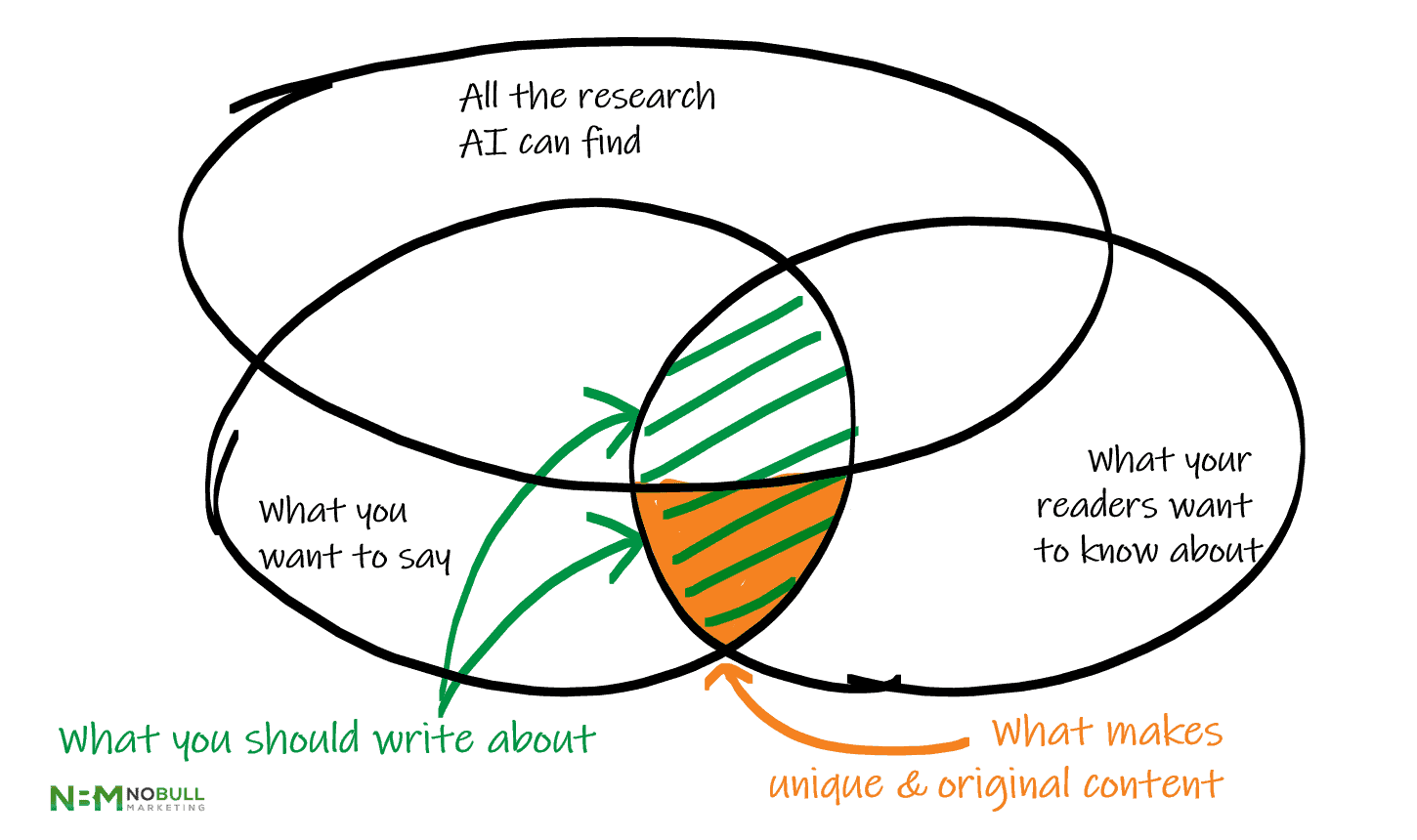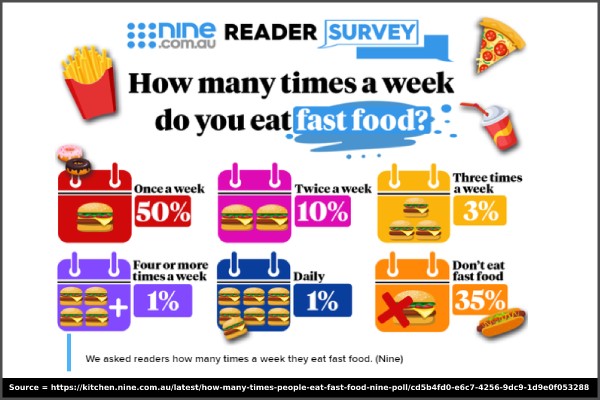Since ChatGPT launched in November 2022, every other person I meet asks me if I’m scared of AI making my job as a copywriter redundant.
Short answer?
I’m not.
Slightly longer answer?
If you’re a copywriter whose process is to research and rehash the top results in Google, it’s time to be scared. If you’re a copywriter who unearths original stories and insights, then uses them to create quality, brand-specific content, there’s nothing to worry about.
The full answer?
This gets really long. It explains why I’m not scared, which means unpacking the stages of a copywriting project and looking at how AI copywriting performs in each stage.
TL;DR
AI is good at broad brush research; generating a list of topics or ideas, and creating a grammatically correct first draft. Fast.
It’s not so good at understanding objectives; doing hyper-targeted research, or identifying inappropriate content.
And it sucks at unearthing original ideas and creating original analogies and metaphors.
That’s likely to mean yet more boring ‘same-as-everyone-else’ content without a spark of anything new. The absolute opposite of anything I offer.
This cartoon from Marijke of Message in a Drawing just about sums it up.

In case you don’t want to take that on trust, let me explain. With examples where possible.
Stages of a copywriting project
Copywriting isn’t just about writing. A lot of the hard work happens before a finger even hits the keyboard. A lot more happens before the first draft. Let’s explore.
Understanding the objective
Every project starts with understanding what the goal is. That informs the next steps. For a good copywriter, different objectives change the approach even before writing starts.
Example: Why do you want to have a blog?
- It helps with SEO. I get more traffic to the site and get leads.
I don’t write for SEO. I write for people first, then optimise for SEO as a secondary objective. I focus on unearthing and communicating specific ideas and stories. We might not be a great fit. (I have turned down clients for exactly this reason!) - I meet lots of people in real life who then check out my website. The blog gives them a chance to learn more about me and what I do.
Brilliant! Let’s talk about the things you want to share with them and how you want to present to them. - I have lots of ideas I share with current clients via email. Putting them into a blog makes those ideas available to more people and builds my SEO.
Ooh, exciting. You’ve probably got loads of content already, although it may need repurposing. (There are some differences between writing for the web and for email.) When can I get a look at it? - I want to promote my expertise to a particular industry segment.
Niching down can be really effective. (This post got me a 20 page website project from a Hong Kong law firm.) Tell me about your target market; what experience you have with them; and how they think their needs are different from other sectors.
AI, on the other hand, won’t even ask the question. It doesn’t care about the why. It will do what you tell it to, even if that’s a dumb idea.
Research
Now that we know why we’re writing, let’s research what we’re going to write. AI can be a great help in this stage. But it can’t do everything.
General content research
AI is great for idea generation. You can go online and look for the most common questions people ask about life insurance, or implementing a work-from-home policy, or buying an investment property. So can AI. It can do it much more quickly and much more thoroughly, too.
AI can also research background information about a topic.
- All the tasks you could outsource to a VA
- How to make laser-cut signs for an event
- A full list of products and services where standard GST rates do not apply (Make sure you specify ‘in Australia’ though!)
It may have more difficulty identifying how that background information matters
- Which tasks are most commonly outsourced to VAs; or easiest to outsource, or save the most time
- What kind of laser cutting projects will have most impact at an event
- The most frequent GST mistakes, or the ones with the greatest consequences
It won’t be able to share an example from your knowledge or your clients. Not unless you’ve already posted that so it’s got into the AI’s dataset – in which case what’s the point?

Factual research
Despite the hype, AI has limitations for factual research. AI copywriting options like ChatGPT, Jasper and Rytr work from datasets which are not updated on a real-time basis. Latest trends and events are likely to be missing.
There’s no fact-checking or verification either. Anyone who’s been following AI in the news this year know that Google’s Bard got information about space satellite photography wrong. But ChatGPT made similar mistakes about early TV cartoons. This second article includes the wonderful line: ‘But will anyone bother to fact-check it?’

These tools also use that data to model language, not to verify facts or statistics. So, for example, if an AI copywriting tool pulls statistics about popular fast food, it doesn’t care whether they come from Wikipedia, the Restaurant and Catering Industry Association of Australia or Aussie Bob’s Fish and Chips.

A human’s level of trust in the statistics depends on where they come from. AI doesn’t even think about trust. (You could say that AI doesn’t even really ‘think’.)
Client-specific and niche-specific research
The best way to explain this is via an example. Imagine you’re writing website copy for a business. One thing any copywriter worth their salt will do is analyse existing reviews.
- What do clients think about this business?
- What do they remember most?
- What words do they use?
I did exactly that recently for a client in the decluttering space. It gave me fantastic insight into what her clients think of her – how she stands out. She’s non-judgmental and compassionate; she takes away things you’d like to donate (as long as they fit in the car) – and perhaps most important of all, she always turns up with a home-made slice.
Could an AI copywriter do this? I’m not aware of one with the capability. There are social media tools which analyse sentiment, and that’s probably the closest service on the market right now. But those ones don’t write copy.
Writing and Editing
There’s no doubt about it, AI copywriting tools can write grammatically correct, natural sounding English.
Unfortunately, they’re not so great in some areas which really add value to writing
- Concrete examples which help people understand and connect
- Inspiring an emotional response
- Persuasive writing (of which emotion is a part)

- Structuring longer pieces to fit well together
- Identifying potentially inappropriate copy
Let’s use a couple of examples to illustrate this.
Example 1: Human vs AI copywriting
This comes from a Guardian article comparing AI copywriting with some human speeches from the Australian parliament.
Can you tell which of these is written by a human and which is AI? If so, how? Take a moment to think before you scroll down.

OK – the answer!
The first one is the human.
The giveaways are in how the language is used to inspire emotion and create implications beyond the immediate obvious. Consider:
- The word ‘even’ doing in ‘difficulty even in obtaining employment’. It’s emphasising how extreme the impact of poor dental care can be.
- Then we have ‘Australians are suffering’.
Not only is ‘suffering’ an emotive word, but the use of ‘Australians’ rather than ‘people’ is significant. It’s invoking our feeling that we are a united national tribe. It’s reminding us (ever so subtly) that this is the Australian Parliament, intended to look after Australians. It’s hinting at a responsibility unfulfilled. - ‘It is time for urgent action.’ This speaker wants something to happen. Now! There’s urgency and emotion.
- Think about the difference between ‘this government’ and ‘the government’. The first one opens up the possibility of a different government which might do better – might have an idea or a comprehensive plan. This invites the reader to imagine an alternative.
Example 2: AI Copywriting in the wild
The second example comes from an AI copywriting webinar I attended. The AI in this case was Jasper, rather than the more famous ChatGPT. Note that Jasper has been around far longer than ChatGPT and is actually designed for copywriting, rather than ‘natural language’.
Now, I’ll admit that the prompt was a bit bizarre – sales copy for Superman underpants. But here’s what the AI copywriter came up with.

Clearly the AI copywriter is completely oblivious to the innuendo of Dad showing off his inner hero via pockets in his underpants!
It’s hard to imagine a human coming up with something this inappropriate. (To be more precise, it’s hard to imagine a human coming up with something this inappropriate, with the actual intention of sharing it with a client.)
What does all this mean for AI copywriting?
As you can see, there are plenty of reasons I’m not scared about AI copywriting just yet.
In fact, I see it as an opportunity. A tool. At NoBull Marketing I can use it for research. It’s a great way to come up with raw material including:
- Topic ideas
- FAQs
- Basic facts and statistics (which will need checking!)
- Features and benefits of a product or service
- Common objections and reasons people don’t buy
But humans are still essential to review, eliminate, re-organise and reword.

Humans are also the ones who add:
- Original stories, examples and metaphors (there are a few in this piece)
- Emotive language
- Original analysis (like dissecting the words from the Guardian)
- Internal structure and connection (so that the ‘how the information matters’ examples reflect the ‘information’ examples just above them
- Humour
- Relevance
- Calls to action
For NoBull Marketing in particular, our entire model is built around helping our clients share their original stories and ideas, which is one thing AI simply cannot do. In fact, the growth of AI could even mean our services become more important. With more and more businesses using the same tools to develop the same content, something a little bit human and a little bit different will stand out even more.
If you’d like help creating original standout content, let’s talk!






